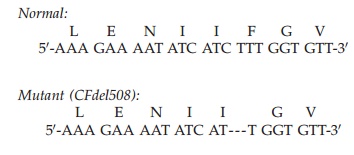Chapter: Pharmaceutical Biotechnology: Fundamentals and Applications : Molecular Biotechnology
DNA Hybridization
DNA Hybridization
To gain insight in the DNA composition, sequencing is the final
approach. There is, however, a possibility to acquire information about DNA
structure by hybridization with the help of so-called DNA probes.
In essence the probe is a specific single-stranded DNA fragment. Such a
probe will form double-stranded DNA (in other words will hybridize) whenever it
encounters a single-stranded complementary piece of DNA under appropriate
conditions. There are many applications for DNA probes.
If, for example, one wishes to see which recombinant DNA molecule in an
extensive DNA library harbors a gene of interest, one might use a DNA probe.
DNAs from the library are converted into single-stranded DNA and then
confronted with a probe that reflects a very characteristic segment of the
desired gene. Hybridization will, provided that the probe has the required
specificity, only occur with target DNA molecules that harbor the gene of
interest.
The use of DNA hybridization probes in diag-nostic testing in humans can
be illustrated by using cystic fibrosis (CF) as an example. The frequency of
this heritable and deadly disease is approximately once in 2000 live births
making it the most frequent genetic disorder among Caucasians. The cloning of
the gene in 1989 based on its position on the human genetic map was a tour de force involving several laboratories. It enabled the molecular analysis of
the genetic defect, revealing that approximately 70% of the diseased genes
contain an identical mutation: a three base pair deletion in the protein coding
gene resulting in the loss of a phenylalanine amino acid at position 508 of the
1480 amino acid-long protein. This mutation was named CFdel 508 and the
knowledge gained was used to design oligonucleotide probes for rapid screening
purposes.
These single-strand DNA probes are comple-mentary to the normal and
CFdel 508 regions of the CF gene shown below. The symbols L, E, etc. represent
various amino acids; F, e.g., stands for phenylalanine.
Normal:

DNA, isolated, e.g., from white blood cells of suspected carriers or
amnion fluid in which embryos are suspended, is boiled to make it single
stranded and then immobilized on filter paper. Next, hybridi-zation with normal
and CFdel 508 specific probes clarifies whether one has the disease, in which
case both the maternal and the paternal genes are affected, or whether one is a
carrier of the disease in which one of the two genes is affected (heterozygosy)
and the other is normal at this genomic position.
Variation on this technology allows for the automated and simultaneous
screening for many genetic diseases for which the molecular lesions are known.
Kits which contain all the reagents necessary for a particular test are
commercially available.
Related Topics